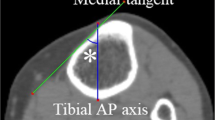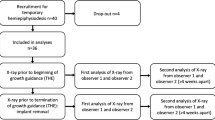Abstract
Purpose
To define osseous landmarks on tibia radiographs in order to establish age-related normal values characterizing physiological tibial bowing in children.
Materials and methods
Five hundred and twenty-six patients aged 0-17 years with normal radiographs of the lower legs were identified and retrospectively reviewed by two blinded radiologists. In anteroposterior (ap)/lateral (lat)-views, 3 lines defined tibial length and angulation. Line-A connecting proximal to distal corner of tibial metaphysic, lines B and C corresponding to corners of tibial metaphysis. Angle A/B defines proximal, A/C distal tibial-angulation. Tibial curvature is defined by distance of line-D parallel to A and tangential to tibial cortex. Normal values were calculated with linear-regression. Intra-/Interreader agreement were tested with a Bland-Altman-plot.
Results
Intrareader-agreement: Reader 1 showed a bias of -0.1, standard-deviation of bias was 1.9 and 95 %-limits-of-agreement -3.9- 3.7. Reader 2: -0.01, 2.4 and -4.7- 4.7. Interreader: 0.2, 1.6 and -2.9- 3.3. Angle-A/B ap was 80-100°, increasing with age (86.5-88); angle-AC ap was 82-107°(96.8-90.5), angle-AB lat was 81-107°(93.0-98.0); angle-AC lat was 76-102 (89.5-86.5); depth of curve ap was 0-11 % (8-3.5) and lat 2-13 %, (8.5-3.5).
Conclusion
Age dependent tibial bowing can be assessed with this new measurement system and age-related normal-values characterizing physiological tibial bowing in children is established.
Key Points
• Tibial Bowing is diagnosed on conventional radiographs.
• Existing Methods provide limited level of confidence.
• New methods provide easy to assess landmarks in all patient ages.
• Existing methods require higher radiation dose compared to new method presented.












Similar content being viewed by others
References
Lovell WW, Winter RB, Morrissy RT, Weinstein SLV (eds) (1996) Lovell and Winter’s pediatric orthopaedics, 4th edn. Lippincott-Raven, Philadelphia, PA, pp 1047–1075
Caffey J (1947) Prenatal bowing and thickening of tubular bones, with multiple cutaneous dimples in arms and legs; a congenital syndrome of mechanical origin. Am J Dis Child 74(5):543–562, 1911
Hofmann A, Wenger DR (1981) Posteromedial bowing of the tibia. Progression of discrepancy in leg lengths. J Bone Joint Surg Am 63(3):384–388
Hefti F, Bollini G, Dungl P, Fixsen J, Grill F, Ippolito E et al (2000) Congenital pseudarthrosis of the tibia: history, etiology, classification, and epidemiologic data. J Pediatr Orthop B 9(1):11–15
Lovell WW, Winter RB, Morrissy RT, Weinstein SLV (eds) (1996) Lovell and Winter’s pediatric orthopaedics, 4th edn. Lippincott-Raven, Philadelphia, PA, pp 305–344
Ablin DS (1998) Osteogenesis imperfecta: a review. Can Assoc Radiol J J Assoc Can Radiol 49(2):110–123
Lovell WW, Winter RB, Morrissy RT, Weinstein SLV (eds) (1996) Lovell and Winter’s pediatric orthopaedics, 4th edn. Lippincott-Raven, Philadelphia, PA, pp 137–201
Schmickel RD, Heidelberger KP, Poznanski AK (1973) The campomelique syndrome. J Pediatr 82(2):299–302
Jackson DW, Cozen L (1971) Genu valgum as a complication of proximal tibial metaphyseal fractures in children. J Bone Joint Surg Am 53(8):1571–1578
Raney EM, Topoleski TA, Yaghoubian R, Guidera KJ, Marshall JG (1998) Orthotic treatment of infantile tibia vara. J Pediatr Orthop 18(5):670–674
Zionts LE, Shean CJ (1998) Brace treatment of early infantile tibia vara. J Pediatr Orthop 18(1):102–109
McCarthy JJ, MacIntyre NR 3rd, Hooks B, Davidson RS (2009) Double osteotomy for the treatment of severe Blount disease. J Pediatr Orthop 29(2):115–119
Masrouha KZ, Sraj S, Lakkis S, Saghieh S (2011) High tibial osteotomy in young adults with constitutional tibia vara. Knee Surg Sports Traumatol Arthrosc Off J ESSKA 19(1):89–93
Putzeys P, Wilmes P, Merle M (2013) Triple tibial osteotomy for the correction of severe bilateral varus deformity in a patient with late-onset Blount’s disease. Knee Surg Sports Traumatol Arthrosc Off J ESSKA 21(3):731–735
Clarke SE, McCarthy JJ, Davidson RS (2009) Treatment of Blount disease: a comparison between the multiaxial correction system and other external fixators. J Pediatr Orthop 29(2):103–109
Bito H, Takeuchi R, Kumagai K, Aratake M, Saito I, Hayashi R et al (2009) A predictive factor for acquiring an ideal lower limb realignment after opening-wedge high tibial osteotomy. Knee Surg Sports Traumatol Arthrosc Off J ESSKA 17(4):382–389
Saragaglia D, Nemer C, Colle P-E (2008) Computer-assisted double level osteotomy for severe genu varum. Sports Med Arthrosc Rev 16(2):91–96
Kodkani PS (2007) Dome osteotomy of the proximal tibia for genu varum treated with a new fixation device. J Knee Surg 20(2):111–119
Paley D, Tetsworth K (1992) Mechanical axis deviation of the lower limbs. Preoperative planning of multiapical frontal plane angular and bowing deformities of the femur and tibia. Clin Orthop 280:65–71
Paley D, Tetsworth K (1992) Mechanical axis deviation of the lower limbs. Preoperative planning of uniapical angular deformities of the tibia or femur. Clin Orthop 280:48–64
Levine AM, Drennan JC (1982) Physiological bowing and tibia vara. The metaphyseal-diaphyseal angle in the measurement of bowleg deformities. J Bone Joint Surg Am 64(8):1158–1163
Paley D (2002) Principles of deformity correction. Springer, Berlin; New York, 806 p
Cheema JI, Grissom LE, Harcke HT (2003) Radiographic Characteristics of Lower-Extremity Bowing in Children1. RadioGraphics 23(4):871–880
Salenius P, Vankka E (1975) The development of the tibiofemoral angle in children. J Bone Joint Surg Am 57(2):259–261
Takatsu T, Itokazu M, Shimizu K, Brown TD (1998) The function of posterior tilt of the tibial component following posterior cruciate ligament-retaining total knee arthroplasty. Bull Hosp Jt Dis N Y N 57(4):195–201
Magerkurth O, Knupp M, Ledermann H, Hintermann B (2006) Evaluation of hindfoot dimensions: a radiological study. Foot Ankle Int Am Orthop Foot Ankle Soc Swiss Foot Ankle Soc 27(8):612–616
Acknowledgments
The scientific guarantor of this publication is Olaf Magerkurth. The authors of this manuscript declare no relationships with any companies, whose products or services may be related to the subject matter of the article. This study has received funding by Pro UKBB Foundation. No complex statistical methods were necessary for this paper. Institutional Review Board approval was obtained. Written informed consent was waived by the Institutional Review Board. Methodology: retrospective, cross sectional study, performed at one institution.
Author information
Authors and Affiliations
Corresponding author
Rights and permissions
About this article
Cite this article
Zbinden, I., Rutz, E., Jacobson, J.A. et al. Tibial bowing in children - what is normal? a radiographic study. Eur Radiol 25, 3459–3471 (2015). https://doi.org/10.1007/s00330-015-3785-1
Received:
Revised:
Accepted:
Published:
Issue Date:
DOI: https://doi.org/10.1007/s00330-015-3785-1




